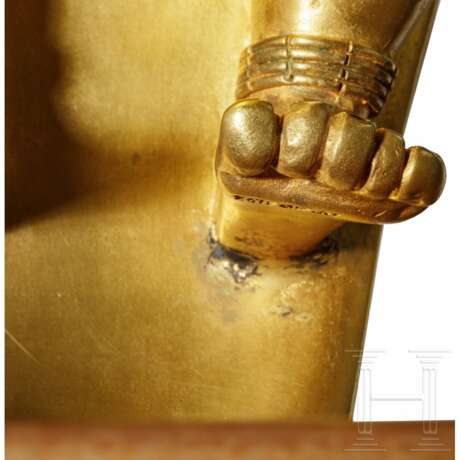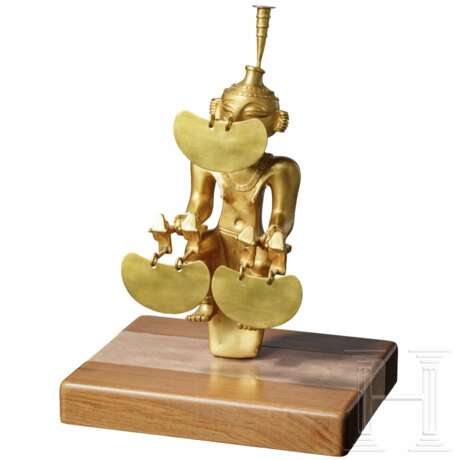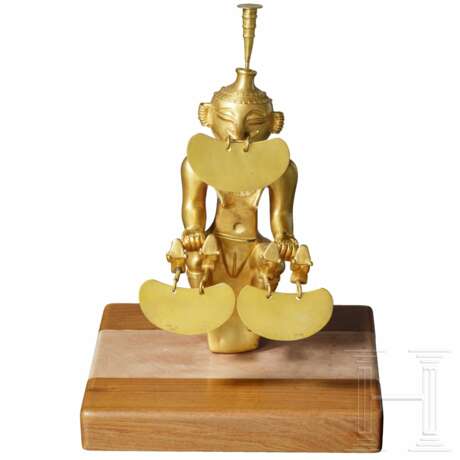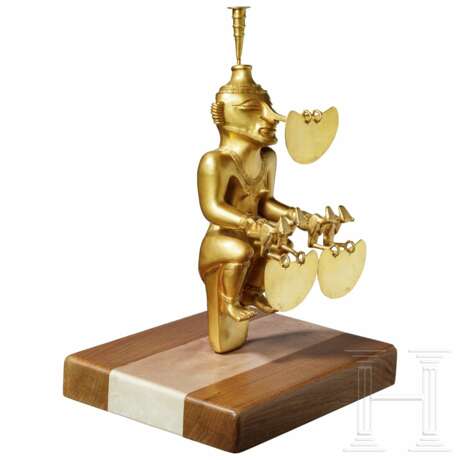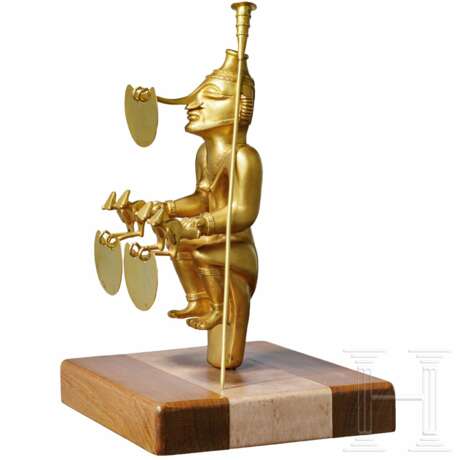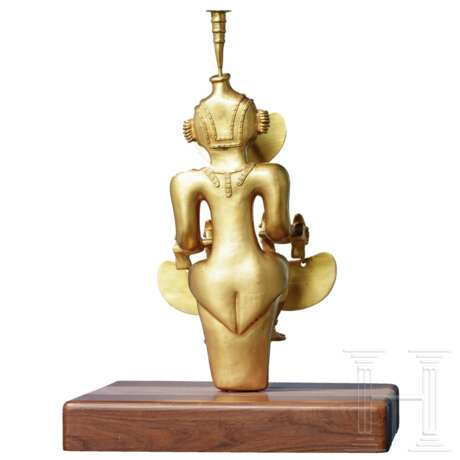ID 658882
Lot 732 | Großes vergoldetes anthropomorphes Gefäß nach einem Vorbild im Museo del Oro
Estimate value
€ 8 000
Silver vase of high artistic quality, elaborately decorated with early Christian symbols. Large and small medallions interconnected centrally around the belly. The smaller ones filled with crosses, in the larger ones alternating the Chi-Rho (with Alpha and Omega), a sheep and a peacock. The symbols are worked in half relief against a gilded background. The Chi-Rho was the major and widely used Christian symbol from the 4th century onwards. The sheep possibly refers to Jesus, the "agnus dei". In early Christian times, the peacock still had a positive connotation: it was considered a bird of paradise and a symbol of heaven, bliss and happiness. The view was widespread that its flesh would not decay, and so it symbolised resurrection and immortality. A gilded geometric ornament at the foot and at the transition from the shoulder to the neck. Intact with few abrasions only. On the underside of the foot ring an antique notch, probably for material testing. Height 30.5 cm. Maximum diameter approx. 16 cm. Weight 1114 g.
The vessel compares closely with high-ranking silver vessels of late antique toreutics.
Provenance: From a South German classical philologist's collection, put together during the 1950s and 1960s. Remaining thereafter in the family estate.
Condition: II
Teilvergoldete frühchristliche Silbervase, 5. - 6. Jhdt.
Seltene und aufwendig mit frühchristlichen Symbolen verzierte silberne Vase von hoher künstlerischer Qualität. Zentral um den Bauch miteinander verbundene große und kleine Medaillons. Die kleineren mit Kreuzen gefüllt, in den größeren abwechselnd das Chi-Rho mit Alpha und Omega, ein Schaf und ein Pfau. Die Symbole sind im Halbrelief vor vergoldetem Hintergrund gearbeitet. Das Chi-Rho war das zentrale und seit dem 4. Jhdt. weithin verbreitete christliche Symbol. Das Schaf soll möglicherweise auf Jesus verweisen, das "Lamm Gottes". Der Pfau war in frühchristlicher Zeit noch positiv besetzt: er galt als Paradiesvogel und Symbol des Himmels, der Seligkeit und des Glücks. Die Ansicht war verbreitet, dass sein Fleisch nicht verwesen würde, und so symbolisierte er Auferstehung und Unsterblichkeit. Am Fuß und am Übergang von der Schulter zum Hals jeweils ein vergoldeter laufender Hund. Intakt mit wenigen Bestoßungen. Auf der Unterseite des Fußrings antike Einkerbung, wohl zur Materialprüfung. Höhe 30,5 cm. Maximaler Durchmesser ca. 16 cm. Gewicht 1114 g.
Das Gefäß kann mit hochrangigen Silbergefäßen der spätantiken Toreutik verglichen werden.
Provenienz: Aus der Sammlung eines süddeutschen Altphilologen, von diesem erworben in den 1950er/1960er Jahren. Dann weiter in Familienbesitz.
Zustand: II
| Auction house category: | Antiques/Gold |
|---|
| Auction house category: | Antiques/Gold |
|---|
| Address of auction |
Hermann Historica Bretonischer Ring 3 85630 Grasbrunn / München Germany | ||||||||||||||
|---|---|---|---|---|---|---|---|---|---|---|---|---|---|---|---|
| Preview |
| ||||||||||||||
| Phone | +49 (0)89 5472 649 0 | ||||||||||||||
| Fax | +49 (0)89 5472 64999 | ||||||||||||||
| Buyer Premium | 25 % | ||||||||||||||
| Conditions of purchase | Conditions of purchase | ||||||||||||||
| Business hours | Business hours
|
